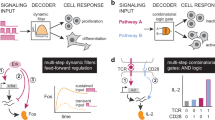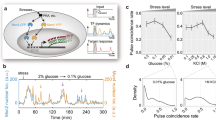Abstract
The duration of intracellular signalling is associated with distinct biological responses, but how cells interpret differences in signal duration are unknown. We show that the immediate early gene product c-Fos functions as a sensor for ERK1 (extracellular-signal-regulated kinase 1) and ERK2 signal duration. When ERK activation is transient, its activity declines before the c-Fos protein accumulates, and under these conditions c-Fos is unstable. However, when ERK signalling is sustained, c-Fos is phosphorylated by still-active ERK and RSK (90K-ribosomal S6 kinase). Carboxy-terminal phosphorylation stabilizes c-Fos and primes additional phosphorylation by exposing a docking site for ERK, termed the FXFP (DEF) domain. Mutating the DEF domain disrupts the c-Fos sensor and c-Fos-mediated signalling. Other immediate early gene products that control cell cycle progression, neuronal differentiation and circadium rhythms also contain putative DEF domains, indicating that multiple sensors exist for sustained ERK signalling. Together, our data identify a general mechanism by which cells can interpret differences in ERK activation kinetics.
This is a preview of subscription content, access via your institution
Access options
Subscribe to this journal
Receive 12 print issues and online access
$209.00 per year
only $17.42 per issue
Buy this article
- Purchase on Springer Link
- Instant access to full article PDF
Prices may be subject to local taxes which are calculated during checkout








Similar content being viewed by others
References
Marshall, C. J. Specificity of receptor tyrosine kinase signaling: transient versus sustained extracellular signal-regulated kinase activation. Cell 80, 179–185 (1995).
Gurdon, J. B., Dyson, S. & St Johnston, D. Cells' perception of position in a concentration gradient. Cell 95, 159–162 (1998).
Weiss, A., Shields, R., Newton, M., Manger, B. & Imboden, J. Ligand-receptor interactions required for commitment to the activation of the interleukin 2 gene. J. Immunol. 138, 2169–2176 (1987).
Iezzi, G., Karjalainen, K. & Lanzavecchia, A. The duration of antigenic stimulation determines the fate of naive and effector T cells. Immunity 8, 89–95 (1998).
Dustin, M. L. & Chan, A. C. Signaling takes shape in the immune system. Cell 103, 283–294 (2000).
Viola, A. & Lanzavecchia, A. T cell activation determined by T cell receptor number and tunable thresholds. Science 273, 104–106 (1996).
Viola, A., Schroeder, S., Sakakibara, Y. & Lanzavecchia, A. T lymphocyte costimulation mediated by reorganization of membrane microdomains. Science 283, 680–682 (1999).
Hunter, T. Signaling — 2000 and beyond. Cell 100, 113–127 (2000).
Vouret-Craviari, V., Van Obberghen-Schilling, E., Scimeca, J. C., Van Obberghen, E. & Pouyssegur, J. Differential activation of p44mapk (ERK1) by α-thrombin and thrombin-receptor peptide agonist. Biochem. J. 289, 209–214 (1993).
Cook, S. J. & McCormick, F. Kinetic and biochemical correlation between sustained p44ERK1 (44 kDa extracellular signal-regulated kinase 1) activation and lysophosphatidic acid-stimulated DNA synthesis in Rat-1 cells. Biochem. J. 320, 237–245 (1996).
Weber, J. D., Raben, D. M., Phillips, P. J. & Baldassare, J. J. Sustained activation of extracellular-signal-regulated kinase 1 (ERK1) is required for the continued expression of cyclin D1 in G1 phase. Biochem. J. 326, 61–68 (1997).
Balmanno, K. & Cook, S. J. Sustained MAP kinase activation is required for the expression of cyclin D1, p21Cip1 and a subset of AP-1 proteins in CCL39 cells. Oncogene 18, 3085–3097 (1999).
Roovers, K., Davey, G., Zhu, X., Bottazzi, M. E. & Assoian, R. K. α5β1 integrin controls cyclin D1 expression by sustaining mitogen-activated protein kinase activity in growth factor-treated cells. Mol. Biol. Cell 10, 3197–3204 (1999).
Heasley, L. E. & Johnson, G. L. The β-PDGF receptor induces neuronal differentiation of PC12 cells. Mol. Biol. Cell 3, 545–553 (1992).
Nguyen, T. T. et al. Co-regulation of the mitogen-activated protein kinase, extracellular signal-regulated kinase 1, and the 90-kDa ribosomal S6 kinase in PC12 cells. Distinct effects of the neurotrophic factor, nerve growth factor, and the mitogenic factor, epidermal growth factor. J. Biol. Chem. 268, 9803–9810 (1993).
Traverse, S. et al. EGF triggers neuronal differentiation of PC12 cells that overexpress the EGF receptor. Curr. Biol. 4, 694–701 (1994).
Stein, R., Orit, S. & Anderson, D. J. The induction of a neural-specific gene, SCG10, by nerve growth factor in PC12 cells is transcriptional, protein synthesis dependent, and glucocorticoid inhibitable. Dev. Biol. 127, 316–325 (1988).
Kovary, K. & Bravo, R. Expression of different Jun and Fos proteins during the G0-to-G1 transition in mouse fibroblasts: in vitro and in vivo associations. Mol. Cell. Biol. 11, 2451–2459 (1991).
Kovary, K. & Bravo, R. Existence of different Fos/Jun complexes during the G0-to-G1 transition and during exponential growth in mouse fibroblasts: differential role of Fos proteins. Mol. Cell. Biol. 12, 5015–5023 (1992).
Greenberg, M. E., Greene, L. A. & Ziff, E. B. Nerve growth factor and epidermal growth factor induce rapid transient changes in proto-oncogene transcription in PC12 cells. J. Biol. Chem. 260, 14101–14110 (1985).
Milbrandt, J. Nerve growth factor rapidly induces c-fos mRNA in PC12 rat pheochromocytoma cells. Proc. Natl Acad. Sci. USA 83, 4789–4793 (1986).
Mehmet, H., Morris, C. & Rozengurt, E. Multiple synergistic signal transduction pathways regulate c-fos expression in Swiss 3T3 cells: the role of cyclic AMP. Cell Growth Differ. 1, 293–298 (1990).
Fambrough, D., McClure, K., Kazlauskas, A. & Lander, E. S. Diverse signaling pathways activated by growth factor receptors induce broadly overlapping, rather than independent, sets of genes. Cell 97, 727–741 (1999).
Greenberg, M. E. & Ziff, E. B. Stimulation of 3T3 cells induces transcription of the c-fos proto- oncogene. Nature 311, 433–438 (1984).
Lau, L. F. & Nathans, D. Identification of a set of genes expressed during the G0/G1 transition of cultured mouse cells. EMBO J. 4, 3145–3151 (1985).
Lallemand, D., Spyrou, G., Yaniv, M. & Pfarr, C. M. Variations in Jun and Fos protein expression and AP-1 activity in cycling, resting and stimulated fibroblasts. Oncogene 14, 819–830 (1997).
Okazaki, K. & Sagata, N. The Mos/MAP kinase pathway stabilizes c-Fos by phosphorylation and augments its transforming activity in NIH 3T3 cells. EMBO J. 14, 5048–5059 (1995).
Chen, R. H., Juo, P. C., Curran, T. & Blenis, J. Phosphorylation of c-Fos at the C-terminus enhances its transforming activity. Oncogene 12, 1493–1502 (1996).
Chen, R. H., Abate, C. & Blenis, J. Phosphorylation of the c-Fos transrepression domain by mitogen- activated protein kinase and 90-kDa ribosomal S6 kinase. Proc. Natl Acad. Sci. USA 90, 10952–10956 (1993).
Favata, M. F. et al. Identification of a novel inhibitor of mitogen-activated protein kinase kinase. J. Biol. Chem. 273, 18623–18632 (1998).
Pritchard, C. A., Samuels, M. L., Bosch, E. & McMahon, M. Conditionally oncogenic forms of the A-Raf and B-Raf protein kinases display different biological and biochemical properties in NIH 3T3 cells. Mol. Cell. Biol. 15, 6430–6442 (1995).
Kamakura, S., Moriguchi, T. & Nishida, E. Activation of the protein kinase ERK5/BMK1 by receptor tyrosine kinases. Identification and characterization of a signaling pathway to the nucleus. J. Biol. Chem. 274, 26563–26571 (1999).
Jacobs, D., Glossip, D., Xing, H., Muslin, A. J. & Kornfeld, K. Multiple docking sites on substrate proteins form a modular system that mediates recognition by ERK MAP kinase. Genes Dev. 13, 163–175 (1999).
Fantz, D. A., Jacobs, D., Glossip, D. & Kornfeld, K. Docking sites on substrate proteins direct extracellular signal- regulated kinase to phosphorylate specific residues. J. Biol. Chem. 276, 27256–27265 (2001).
Miller, A. D., Curran, T. & Verma, I. M. c-fos protein can induce cellular transformation: a novel mechanism of activation of a cellular oncogene. Cell 36, 51–60 (1984).
Jordan, J. D., Landau, E. M. & Iyengar, R. Signaling networks: the origins of cellular multitasking. Cell 103, 193–200 (2000).
Curran, T., Miller, A. D., Zokas, L. & Verma, I. M. Viral and cellular fos proteins: a comparative analysis. Cell 36, 259–268 (1984).
Harada, T., Morooka, T., Ogawa, S. & Nishida, E. ERK induces p35, a neuron-specific activator of Cdk5, through induction of Egr1. Nature Cell Biol. 3, 453–459 (2001).
Akashi, M. & Nishida, E. Involvement of the MAP kinase cascade in resetting of the mammalian circadian clock. Genes Dev. 14, 645–649 (2000).
Abate, C., Luk, D., Gentz, R., Rauscher, F. J. 3rd & Curran, T. Expression and purification of the leucine zipper and DNA-binding domains of Fos and Jun: both Fos and Jun contact DNA directly. Proc. Natl Acad. Sci. USA 87, 1032–1036 (1990).
Kato, Y. et al. BMK1/ERK5 regulates serum-induced early gene expression through transcription factor MEF2C. EMBO J. 16, 7054–7066 (1997).
Khokhlatchev, A. et al. Reconstitution of mitogen-activated protein kinase phosphorylation cascades in bacteria. Efficient synthesis of active protein kinases. J. Biol. Chem. 272, 11057–11062 (1997).
Richards, S. A., Fu, J., Romanelli, A., Shimamura, A. & Blenis, J. Ribosomal S6 kinase 1 (RSK1) activation requires signals dependent on and independent of the MAP kinase ERK. Curr. Biol. 9, 810–820 (1999).
Chen, R. H., Sarnecki, C. & Blenis, J. Nuclear localization and regulation of erk- and rsk-encoded protein kinases. Mol. Cell. Biol. 12, 915–927 (1992).
Chen, R. H. & Blenis, J. Identification of Xenopus S6 protein kinase homologs (pp90rsk) in somatic cells: phosphorylation and activation during initiation of cell proliferation. Mol. Cell. Biol. 10, 3204–3215 (1990).
Chung, J., Chen, R. H. & Blenis, J. Coordinate regulation of pp90rsk and a distinct protein- serine/threonine kinase activity that phosphorylates recombinant pp90rsk in vitro. Mol. Cell. Biol. 11, 1868–1874 (1991).
Acknowledgements
We thank T. Curran, J.-D. Lee, M. Cobb and M. McMahon for reagents. We also thank J. Brugge, T. Rapoport and members of the Blenis laboratory for critical reading of this manuscript, and J. Brugge, L. Cantley, B. Neel, and A. Kazlauskas for many helpful discussions. This work was supported by National Institutes of Health grant RO1CA46595 (J.B.), a Special Grant for Research from the American Cancer Society, New England Division (L.O.M.) and NIH grants F32-CA68712 (S.S.) and F32-CA69808 (D.C.F.).
Author information
Authors and Affiliations
Corresponding author
Ethics declarations
Competing interests
The authors declare no competing financial interests.
Supplementary information
Supplementary figure
Figure S1. Nuclear accumulation of active ERK1/2 and c-Fos in growth factor- treated Swiss 3T3 cells. addition of cycloheximide (+) or vehicle (-). (PDF 1322 kb)
Rights and permissions
About this article
Cite this article
Murphy, L., Smith, S., Chen, RH. et al. Molecular interpretation of ERK signal duration by immediate early gene products. Nat Cell Biol 4, 556–564 (2002). https://doi.org/10.1038/ncb822
Received:
Revised:
Accepted:
Published:
Issue Date:
DOI: https://doi.org/10.1038/ncb822
This article is cited by
-
γδ T cells: origin and fate, subsets, diseases and immunotherapy
Signal Transduction and Targeted Therapy (2023)
-
High-throughput spatiotemporal monitoring of single-cell secretions via plasmonic microwell arrays
Nature Biomedical Engineering (2023)
-
Eucalyptol induces osteoblast differentiation through ERK phosphorylation in vitro and in vivo
Journal of Molecular Medicine (2023)
-
The Role of p90 Ribosomal S6 Kinase (RSK) in Tyrosine Kinase Inhibitor (TKI)-Induced Cardiotoxicity
Journal of Cardiovascular Translational Research (2023)
-
Structural Plasticity of Dopaminergic Neurons Requires the Activation of the D3R-nAChR Heteromer and the PI3K-ERK1/2/Akt-Induced Expression of c-Fos and p70S6K Signaling Pathway
Molecular Neurobiology (2022)



